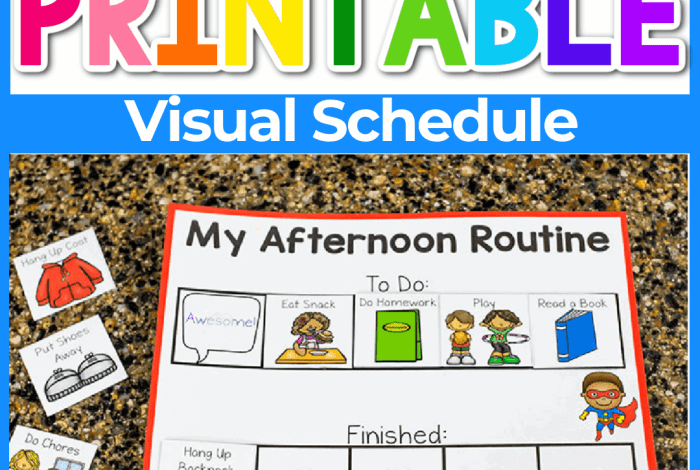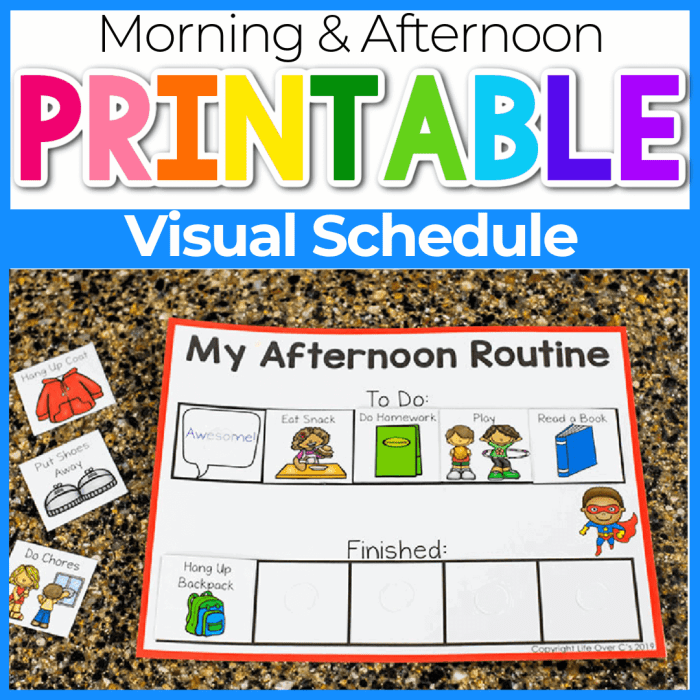
How to Create a Visual Schedule for Your Family
How to create a visual schedule for your family can be a game-changer for households of all sizes. Visual schedules provide a clear, consistent roadmap for everyone, making it easier to manage time, expectations, and even reduce stress. Whether you have young children just learning to navigate their day or teenagers with busy schedules, a visual schedule can bring structure and clarity to your family life.
Imagine a world where everyone knows what’s happening next, where transitions are smoother, and where everyone feels more confident and in control. This is the power of a visual schedule. This guide will walk you through the steps of creating a schedule that works for your family, from understanding the benefits to implementing and adapting it for your unique needs.
Tips for Success: How To Create A Visual Schedule For Your Family
Creating and implementing a visual schedule is a fantastic step towards establishing routines and predictability for your family. However, maintaining consistency and motivation is crucial for long-term success. This section will provide you with practical tips and strategies to overcome common challenges, ensuring your visual schedule remains effective and enjoyable for everyone.
Maintaining Consistency and Motivation
It’s essential to maintain consistency with your visual schedule for it to be effective. This means sticking to the schedule as much as possible, even when things get hectic. Here are some tips to help you maintain consistency:
- Start small: Don’t try to implement the entire schedule at once. Start with a few key activities and gradually add more as your family adjusts. This helps prevent overwhelm and allows for smoother integration.
- Be flexible: While consistency is important, it’s also okay to be flexible. Life happens, and sometimes you may need to adjust the schedule. However, try to keep adjustments to a minimum and explain the reason for the change to your children.
This helps them understand that the schedule is not set in stone and promotes adaptability.
- Use visual reminders: Place the visual schedule in a prominent location where everyone can see it. This serves as a constant reminder of the day’s activities and helps everyone stay on track. You can also use visual timers or countdown clocks to help children understand the duration of each activity.
- Involve your children: Let your children participate in creating the schedule, choosing the images, and even helping to arrange them. This fosters a sense of ownership and increases their buy-in. It also allows you to tailor the schedule to their interests and needs.
- Make it fun: Use colorful images, stickers, and rewards to make the schedule more engaging. You can also incorporate games or activities that reinforce the schedule. For example, you could have a “treasure hunt” where children have to find the next activity on the schedule.
Positive Reinforcement Strategies, How to create a visual schedule for your family
Positive reinforcement is a powerful tool for motivating children to follow the visual schedule. This involves rewarding desired behaviors, such as completing activities on time or transitioning smoothly between activities. Here are some positive reinforcement strategies you can use:
- Verbal praise: Simple but effective! Praise your children for following the schedule and completing activities. Be specific about what you are praising, such as “You did a great job cleaning up your toys!”
- Tangible rewards: Offer small, age-appropriate rewards for completing activities. This could be a sticker, a small toy, or extra playtime. Avoid using food as a reward, as it can lead to unhealthy eating habits.
- Special privileges: Allow your children to earn special privileges, such as watching a favorite TV show or playing a game, for completing the schedule. This can be a powerful motivator for children who are motivated by rewards.
- Social rewards: Offer social rewards, such as spending extra time with you or playing a game together. This is especially effective for children who are motivated by social interaction.
Troubleshooting Common Challenges
Despite your best efforts, you may encounter some challenges when implementing a visual schedule. Here are some tips for troubleshooting common issues:
- Resistance to change: Children may resist change, especially if they are used to a more unstructured routine. Start slowly, introduce the schedule gradually, and be patient. It may take some time for them to adjust.
- Difficulty understanding the schedule: If your children have difficulty understanding the schedule, try using simpler images or symbols. You can also use a combination of images and words. For younger children, you may need to use a more simplified version of the schedule with fewer activities.
- Lack of motivation: If your children are not motivated to follow the schedule, try incorporating more positive reinforcement strategies. You can also involve them in the creation of the schedule to increase their buy-in.
- Overwhelmed by the schedule: If your children seem overwhelmed by the schedule, try simplifying it. Remove some activities or break down activities into smaller steps. You can also use a timer to help them understand the duration of each activity.
Visual Schedule Examples

Visual schedules can be tailored to meet the needs of different families. Here are some examples of visual schedules for families with young children, teenagers, and those with special needs.
Visual Schedule Example for Families with Young Children
Visual schedules for young children can be simple and engaging. They can use pictures, symbols, or a combination of both.
- Picture Schedule:This type of schedule uses pictures to represent each activity. For example, a picture of a toothbrush could represent “brushing teeth” or a picture of a plate with food could represent “breakfast.” Picture schedules are particularly useful for younger children who are still learning to read.
- Symbol Schedule:This type of schedule uses symbols to represent each activity. Symbols can be drawn, cut out from magazines, or purchased online. For example, a circle could represent “playtime” or a square could represent “naptime.” Symbol schedules are a good option for children who are visually oriented or who have difficulty with reading.
Visual Schedule Example for Families with Teenagers
Teenagers may not need as much visual support as younger children, but they can still benefit from a visual schedule. Visual schedules can help teenagers stay organized and manage their time effectively.
- Digital Schedule:Teenagers are often comfortable with technology, so a digital schedule might be a good option. Digital schedules can be created using apps, websites, or spreadsheets. They can include reminders, deadlines, and even links to important documents.
- Color-Coded Schedule:This type of schedule uses different colors to represent different activities. For example, green could represent schoolwork, blue could represent extracurricular activities, and yellow could represent free time. Color-coded schedules can help teenagers quickly see what they have planned for the day.
Visual Schedule Example for Families with Special Needs
Families with special needs may need to create a visual schedule that is tailored to the individual needs of their child. This might involve using a combination of pictures, symbols, and written words.
- Object Schedule:This type of schedule uses actual objects to represent each activity. For example, a toothbrush could represent “brushing teeth” or a toy car could represent “playtime.” Object schedules can be very helpful for children who are tactile learners or who have difficulty understanding abstract concepts.
- Multi-Sensory Schedule:This type of schedule uses multiple senses to represent each activity. For example, a picture of a book could be accompanied by the sound of a book being read or the smell of a book. Multi-sensory schedules can be very engaging for children who learn best through multiple senses.
Creating a visual schedule for your family can be a lifesaver, especially for younger kids who thrive on routine. It can be as simple as a whiteboard with colorful markers, or you can get fancy with online tools like gimme some love , which offers customizable templates and fun icons.
The key is to make it visually appealing and easy to understand, so everyone in the family knows what’s happening and when.
Creating a visual schedule for your family can be a fun and creative process. You can use colorful pictures, stickers, or even personalized items like mod podge shoes to represent different activities. This can make it easier for kids to understand the daily routine and feel more involved in the planning.
Remember, the key is to make it visually appealing and engaging for everyone in the family.
Creating a visual schedule for your family can be a great way to keep everyone on track, especially during busy times like Halloween. You can use pictures, symbols, or even a fun list of “candy tricks or treats” candy tricks or treats to represent different activities.
This visual reminder can help kids understand what to expect throughout the day and can make transitions smoother, reducing stress for everyone involved.






